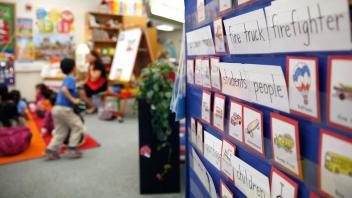The scientific research on vocabulary instruction reveals that most vocabulary is learned indirectly and that some vocabulary must be taught directly. Thus, research supports using a combination of both indirect and direct approaches.
Indirect vocabulary learning
Children learn the meanings of most words indirectly, through everyday experiences with oral and written language. Children learn word meanings indirectly in three ways:
1. They engage daily in oral language
Young children learn word meanings through conversations with other people, especially adults. As they engage in these conversations, children often hear adults repeat words several times. They also may hear adults use new and interesting words. The more oral language experiences children have, the more word meanings they learn.
2. They listen to adults read to them
Children learn word meanings from listening to adults read to them. Reading aloud is particularly helpful when the reader pauses during reading to define an unfamiliar word and, during and after reading, engages the child in a conversation about the book. Conversations about books help children to learn new words and concepts and to relate them to their prior knowledge and experience.
Children’s books typically contain more unusual, sophisticated words — new vocabulary words — than does everyday conversation (see The Words Children Hear: Picture Books and the Statistics for Language Learning , 2015). One reason why reading aloud to children is so important is that it increases children’s exposure to new vocabulary.
3. They read extensively on their own
Children learn many new words by reading extensively on their own. The more children read on their own, the more words they encounter and the more word meanings they learn.
Unfortunately, the children who often need vocabulary development the most — struggling readers — tend to be those who read the least, because of limitations in their skills or because they have had so many failure experiences with reading that they lack motivation to read. This is one reason why it’s important to combine direct teaching methods with indirect vocabulary learning.
Direct vocabulary learning
Although a great deal of vocabulary is learned indirectly, some vocabulary should be taught directly.
Direct instruction helps students learn difficult words, such as words that represent complex concepts that are not part of the students’ everyday experiences. Direct instruction of vocabulary relevant to a given text leads to better reading comprehension.
Direct instruction includes:
- Providing students with instruction in specific words that are important to students’ content learning or understanding of a particular text
- Teaching students more general word-learning strategies that they can apply to a variety of words, such as analyzing parts of words (e.g., root words)
Teaching specific words before reading can help both vocabulary learning and reading comprehension.
Before students read a text, it can be helpful to teach them specific words that they will see in the text and that are particularly important to understanding the text. Literacy expert Tim Shanahan recommends that you choose words to preteach with care. An important part of vocabulary learning is developing an ability to use context to determine meanings of unknown words. In this blog post, Eight Ways to Help Kids to Read Complex Text , he says: “If a word is explained in the text or you think kids can figure it out from context, do not take time to preteach it. But words that you don’t think students will know, tell them ahead of time.”
Providing instruction over an extended period of time encourages students to use vocabulary in different contexts — both in spoken and written communication.
Children learn words best when they are provided with instruction over an extended period of time and when that instruction has them work actively with the words – for example, using new words in their writing. The more students use new words and the more they use them in different contexts, the more likely they are to learn the words.
Repeated exposure to vocabulary in many contexts aids word learning.
Students learn new words better when they encounter them often and in various contexts. The more children see, hear, and work with specific words, the better they seem to learn them.
When we provide extended instruction that promotes active engagement, we give our students repeated exposure to new words. When our students read those same words in their texts, they increase their exposure to the new words.
Exposure to words in many contexts also gives students a deeper understanding of the meaning of a word and how it is likely to be used. For instance, miserly and thrifty are both adjectives that describe a person who avoids spending money, but thrifty has a much more positive connotation than miserly.
List-Group-Label
Go inside Cathy Doyle’s second grade classroom in Evanston, Illinois, to observe her students learning the list-group-label strategy. Cathy builds the lesson around the concept of gardening, based on a recent classroom read-aloud, The Gardener. Joanne Meier, our former research director, introduces the strategy and highlights the vocabulary and comprehension skills that list-group-label supports.
